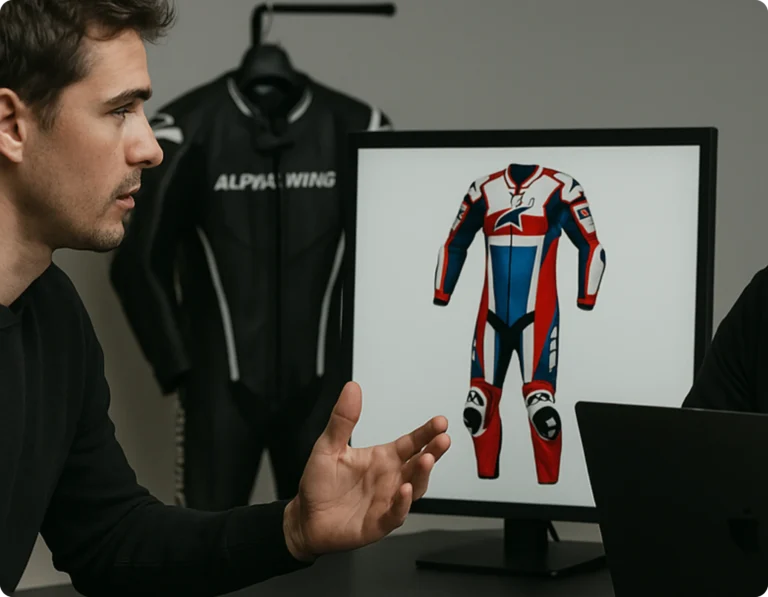Blog
How Motorbike Suits Improve Track Safety?

When you’re racing on a motorbike, safety comes first. The track is fast and full of risks. That’s why your gear must protect you at every turn. One of the most important pieces of safety gear is your racing suit. Let’s explore how motorbike suits improve track safety and why every rider should wear one.
Why Racing Suits Matter
Motorbike racing suits are not just for style—they are made to save lives. These suits are built to handle high speeds, crashes, and extreme weather. Whether you’re a pro racer or a beginner, the right suit gives you protection and confidence.
How Motorbike Suits Improve Track Safety
Let’s look at the key ways motorbike suits help you stay safe while racing:
1. Crash Protection
Racing suits are made from thick leather or tough fabric that can slide on the track without tearing. This protects your skin from road rash in case of a fall.
- Cowhide or kangaroo leather resists tearing
- Padding helps reduce injuries in a crash
- Reinforced areas like knees, elbows, and shoulders
2. Built-In Body Armor
Good motorbike suits come with CE-certified armor. These are special pads placed in areas that need extra protection:
- Shoulders
- Elbows
- Knees
- Back
- Sometimes even the chest
This armor absorbs impact and keeps your bones and joints safe during a fall.
3. Fire and Heat Resistance
Track crashes can sometimes lead to sparks or fuel leaks. Racing suits made with fire-resistant material help protect you from burns.
- Many leather suits are treated to resist heat
- Kevlar panels can withstand high temperatures
4. Temperature Control
Staying cool or warm affects your focus and performance. Racing suits are made to breathe, keeping you cool during hot races or warm in cold weather.
- Perforated leather allows airflow
- Linings can absorb sweat
- Some suits include vent zippers
5. Proper Fit Prevents Distractions
A well-fitted suit stays in place, so you don’t have to adjust it during the race. That means better focus and fewer mistakes.
- Custom suits match your body shape
- Less flapping and folding at high speeds
- No loose armor moving inside the suit

6. Visibility on the Track
Bright colors and reflective patches on racing suits make you easier to spot, especially during fast group races.
- Helps marshals see you if you fall
- Improves rider awareness during overtakes
Materials That Support Track Safety
Some of the best materials used in racing suits include:
- Cowhide Leather – Durable and thick
- Kangaroo Leather – Light but strong
- Kevlar Panels – Extra tear and heat resistance
- Textile (in rare cases) – Often used in non-racing gear
Safety Features to Look For
When buying a racing suit, make sure it includes:
- CE Level 1 or Level 2 armor
- Double or triple stitching
- Sliders on knees and elbows
- Reinforced seams
- Hump at the back (for airflow and spine protection)
Should You Get a Custom Racing Suit?
Yes, if you ride regularly on track or plan to race competitively. Custom Racing suits offer:
- Better fit
- Better airflow
- Armor stays in the right place
- Less drag at high speeds
Conclusion
Motorbike suits improve track safety in many ways—from crash protection and armor to comfort and visibility. No rider should go on the track without one. Whether you’re just starting or have years of racing experience, investing in a quality racing suit is one of the best things you can do for your safety.
Read More Best Materials for Motorbike Racing Suits
FAQs
1. Do I need a racing suit if I wear pads and a jacket?
Yes. Racing suits offer full-body protection, while jackets leave areas like hips and legs exposed.
2. What’s the best material for a safe racing suit?
Cowhide or kangaroo leather with CE-approved armor is the safest choice for track riders.
3. Are custom suits safer than off-the-rack ones?
Custom suits fit better, which keeps armor in place and reduces distractions, making them safer overall.
4. What is CE armor in a racing suit?
CE armor is certified protective padding placed in high-risk areas like knees, shoulders, and elbows.
5. How long does a racing suit last?
With proper care, a good leather racing suit can last 5–7 years or more.

